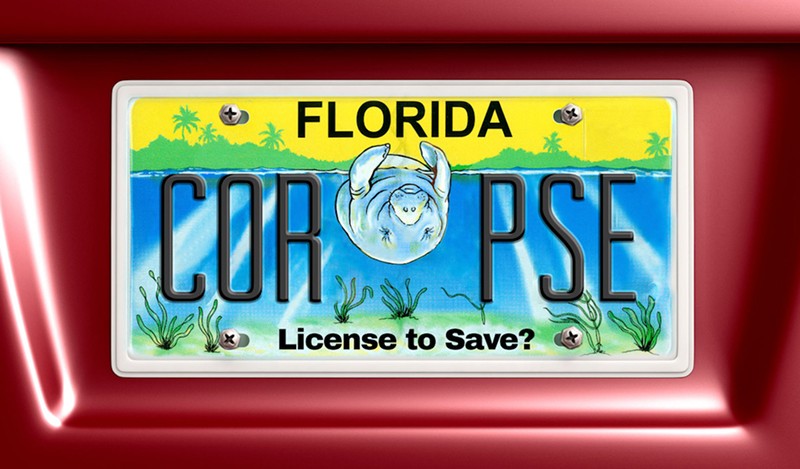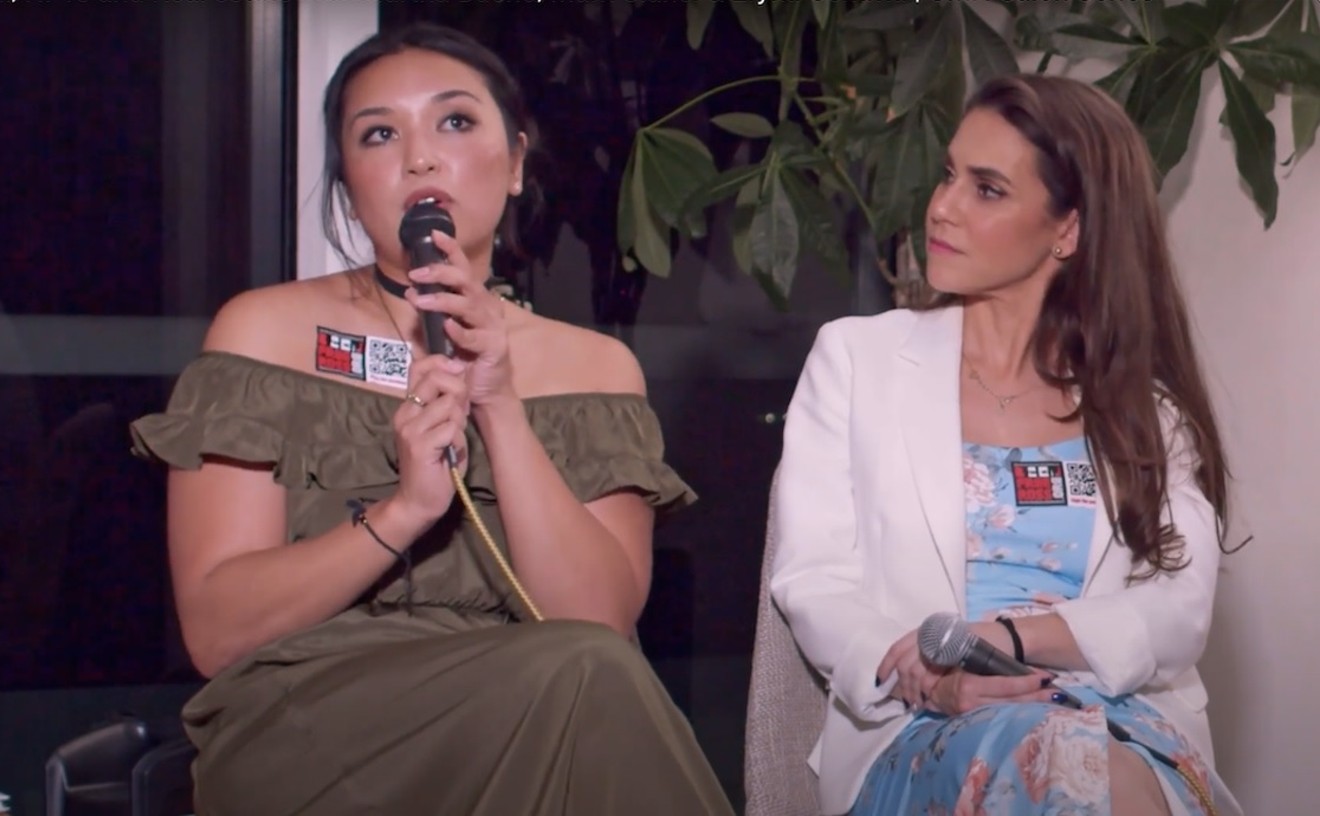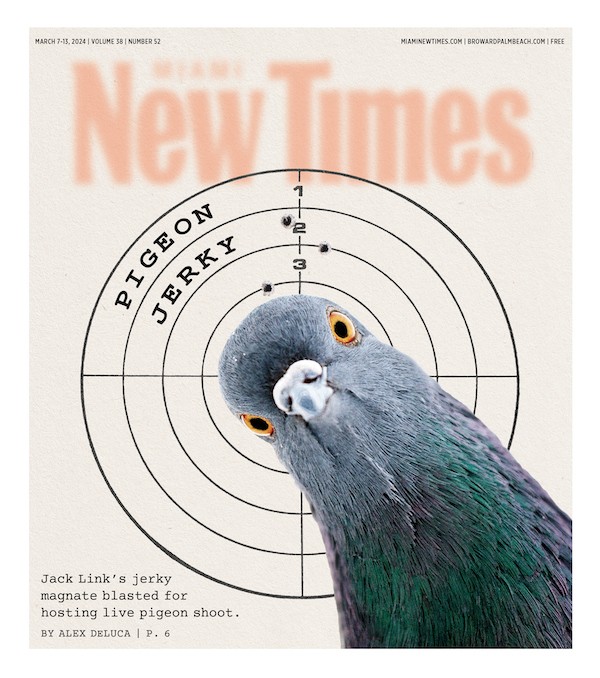On a recent Monday morning, the agency — tucked away between a women's clothing boutique and a Japanese/Thai fusion restaurant — is surprisingly quiet. A giggling toddler sporting a blue Monsters Inc. shirt waddles around the small office, eliciting smiles from the clerks as his father waits in line. Every few minutes, a digital LED number sign updates from one figure to the next as a clerk shouts the numbers aloud in tandem: "20!" "21!"
On the back wall, behind the take-a-number dispenser and clerk counter, 62 specialty Florida license plates are displayed vertically to fit on two shelves spanning more than ten feet each. The tags are displayed in alphabetical order, pledging allegiance to everything from Florida law enforcement to wild dolphins to the NASCAR Foundation.
A longtime clerk at the agency, Kayla McVicker, proudly hoists the specialty tag she recently bought for herself: the new Conserve Wildlife plate, which debuted in May and features a Florida black bear posing against a turquoise sky. As McVicker runs her hand along the rows of specialty tags behind her, she lists off the most popular ones the agency purveys: the Miami Heat tag, the University of Miami tag, the University of Florida tag, and the Endless Summer tag, the last of which features a surfer’s silhouette against an orange-and-red sky. Recently, she says, she’s noticed that a lot more people are buying the new Walt Disney World tag.
When asked whether anyone is purchasing the specialty license plates that support the state’s endangered and threatened species, such as the Protect the Panther and Save the Manatee tags, McVicker shrugs.
“Not so much anymore.”
All told, more than 100 specialty license plates are available across the state of Florida today. It might seem like just another bureaucratic obligation, but the license plate a Florida car owner chooses (or doesn’t choose) determines how much money state officials may allocate to protect and conduct research for threatened manatees or the endangered Florida panther. That’s because Florida is one of several U.S. states that takes in a significant portion of its funding for its endangered-wildlife programs — such as the Florida Panther Program and Florida Manatee Program — through the sale of specialty license plates.
Every penny of every dollar spent on a Save the Manatee or Protect the Panther license plate goes directly to the Florida Fish and Wildlife Conservation Commission (FWC) to fund its respective programs. These specialty plates brought in $3.4 million for panthers during the 1998-99 fiscal year and $2.6 million for manatees during the 1999-00 fiscal year. However, these plates are bringing in millions less today. During the 2020-21 fiscal years, the panther plates brought in just under $1.1 million while the manatee plates brought in $1,023,835 — the lowest year on record.
This comes as the number of specialty license plates available to Florida motorists has skyrocketed, from about a dozen in 1987 to 120 and counting as we head into 2022. Gov. Ron DeSantis signed a bill in September of 2020 approving 32 new specialty tags, including a Florida Stands With Israel tag, an In God We Trust tag, and a Don’t Tread on Me Gadsden Flag tag, which benefit the Hatzalah of Miami-Dade, the Tennessee-based American Eagle Foundation, and the Florida Veterans Foundation, respectively.
If relying on Floridians’ purchase of the cartoonish manatee and serene panther tags over the striking sunset silhouettes of the Endless Summer tags or the sleek all-black design of the Miami Heat tag seems like a ridiculous and flawed approach to ensure the survival of Florida’s endangered state animal and Florida’s threatened state marine mammal, well, that’s because it is.
"In the early days, the Save the Manatee license tag and Challenger tag were sort of the two big ones, and then the Panther tag came along," says Patrick Rose, an aquatic biologist and Save the Manatee Club’s executive director. "But now we have dozens and dozens and dozens of tags, so the Save the Manatee plate kind of gets diluted because people have so many choices."
Rose can’t help but feel let down. In 2017, the United States Fish and Wildlife Service (FWS) unanimously voted to take manatees off the Endangered Species List, continuing a downward trajectory in federal funds for the creatures — even as 2021 is on track to be the deadliest year for manatees with more than 1,000 documented deaths so far.
"It’s not going to be sufficient," Rose sighs, referring to the most recent Save the Manatee tag sales. "But were the license plates not there, it would be devastating."
The Beginning
License plates first became available in Florida in 1906. Those original plates were crafted out of dark leather and metal lettering. A whopping 174 vehicles were registered, most of them powered by steam. There was no Department of Motor Vehicles, no tag agencies; most residents bought their plates at local hardware stores.But the leather didn't hold up too well in the subtropical climate. By 1910, the state re-designed the plates to be all-metal, then porcelain, and eventually tin. (Today, the plates are made with a reflective metal material that often glints in the sunlight.)
The Florida Legislature launched the state's first uniform license plate in 1917; these were steel plates with yellowish lettering. Over the next several decades, dozens of new license plates were unveiled, touting aspects of the state's sun-splashed identity: a yellow grapefruit tag in 1935 that was quickly decommissioned because the fruits resembled bombs; a "Sunshine State" tag with red lettering in 1949; and a Disabled Veteran tag in 1951.
It wasn't until the late 1980s that specialty license plates benefiting different causes hit the streets. In 1987, a year after the tragic Challenger space shuttle explosion that killed seven astronauts at Cape Canaveral, the legislature created Florida's first-ever specialty tag to honor the fallen crew and benefit the Brevard County-based Astronaut Memorial Foundation. By 2000, more than 52,000 vehicles across the state displayed the Challenger tag with its powder-blue outline of the shuttle blasting off into the sky.
By 2003, it had raised more than $28 million for the foundation. Today, the plate is attached to only 18,000 vehicles.
In 1990, the carcasses of 41 manatees were found in the state's waterways — an uptick of more than two dozen from the previous year. Though manatees were one of the first species to be included on the federal Endangered Species Act when it passed in 1973 — receiving financial assistance and federal protections, including laws that made it illegal to feed, harass, or harm the animals — financial support was scarce on a state level.
"During those years, there was so much work to be done and not nearly enough funding to do it," Rose says.
The dire situation of the manatees and the promise of the Challenger tag sparked an idea among the leaders of the Save the Manatee Club, a nonprofit group and membership-based organization looking to protect the manatee and its habitat. Founded in 1981 with a boost from musician Jimmy Buffett, it's by no means a state agency.
Rose says the club decided years ago to create a Save the Manatee tag and allocate all the funds from its sale to the FWC's manatee program. Rose, who once worked as the state's first manatee and marine mammal administrator, understood that the FWC needed the funds more than the club did.
So he and Judith Valee, the Save the Manatee club's former executive director, began searching for a legislative sponsor to help them pass a bill in the Florida Legislature to create the Save the Manatee tag. After club members, including Buffett, made several appearances at Florida's Capitol, the bill passed and the tag debuted in January 1990. It depicted a gray and black manatee against a light-blue body of water.
Since then, the Save the Manatee tag's $25 annual fee has made up nearly one-third of the FWC's Save the Manatee Trust Fund — the primary source of funding for the state's manatee research, rescue, and conservation efforts.
"There's been a long history of having to figure out how to find the money to do what the science tells us because not a lot of general revenue money goes to manatee work," Rose explains. "So it's quite often you have to come up with things like license plates or registration fees in order to fund the programs."
In its first year, the Save the Manatee plates raised nearly $1.3 million for the endangered sea cows.
It wasn't long before legislators introduced a tag to support an even more endangered species: the state animal, the Florida panther, which was estimated to have fewer than 30 cats across the state in the early '90s. Panthers, like the manatees, were federally endangered yet lacked state funding for research and conservation efforts. The Protect the Panther tag — which displayed black lettering and a scrawny, tan panther on a patch of green grass — debuted in 1991.Gov. Ron DeSantis signed HB1135, which approved 32 new specialty license plates.
tweet this
Roughly three years after its introduction, it was redesigned to feature a more detailed illustration of the cat's face to "increase its attractiveness and marketability," according to the Florida Department of Highway Safety and Motor Vehicles (FLHSMV).
Through the $25 annual fee, the Protect the Panther tag raised $27 million for the state's panther program in just ten years. At one point, the tag was the top-selling tag across Florida.
Within the first several years of the two tags' debuts, tens of millions of dollars were collected to fund much-needed conservation and research in Florida to keep the elusive panthers and skittish manatees from going extinct.
"The tags made all the difference in the world," Rose says.
Then, like all good things, it came to an end.
Too Much of a Good Thing
Legally, all Florida drivers are required to display a license plate on the back of their motorized vehicle and replace the tag every ten years. The plates are sold at authorized motor vehicle offices across the state, including the DMV, local tax collectors, and tag agencies. Drivers have the option of buying a standard license plate for $28 or a specialty license plate, which can cost an extra $15 to $25 annually.By default, Florida drivers across the state receive the standard plate, which displays two oranges and an orange blossom. Several variations of the tag are available today, including one with the words "Sunshine State" at the bottom and another with the phrase "In God We Trust." Of the nearly 3.3 million tags issued this year, the standard plate is by far the dominant tag on Florida's roads.
But after FLHSMV introduced the Challenger tag in 1987, the Save the Manatee tag in 1990, and the Protect the Panther tag in 1991 — collectively raising more than $100 million by 2005 — other causes began to crowd the specialty-plate market.
In 1991, the Quincentennial tag — a white tag that displayed the words "Columbus Jubilee" in red and blue lettering — was introduced, honoring Florida's 500th anniversary and participation in the 1992 World's Fair.
After the 9/11 attacks in 2001, the United We Stand tag — which features the Florida state flag and American flag waving on a pole — debuted to support security-related aviation projects within the Department of Transportation.
By 2003, nearly two dozen university and college tags were created to fund scholarships for students. A faith-based Parents Make a Difference tag was added in 2004 to benefit the evangelical group the Gathering, which is said to promote "family values" that include opposition to gay and reproductive rights.
By 2015, there were scores of new tags benefiting the Masonic Home Endowment Fund, the Police and Kids Foundation, the NASCAR Foundation, the Miami Dolphins Foundation, the Guy Harvey Ocean Foundation, the Big Brothers Big Sisters Association, the Florida Sheriffs Association, Keiser University, the Moffitt Cancer Center, and the Tampa Bay Buccaneers Foundation.
In September 2020, Gov. Ron DeSantis signed HB1135, which approved 32 new specialty license plates — 28 of them with the caveat that at least 3,000 Florida motorists signed up for them in advance. (The other four, which benefit state universities in Georgia and Alabama, required a minimum of 4,000 presale vouchers.)
The bill also established a cap of 150 specialty tags and formalized a "discontinuation process" for any specialty license plate that has its registration fall below 3,000 motorists for at least a year. The quota was previously 1,000, and specialty plates supporting the St. Johns River, the Hispanic Achievers, and the American Red Cross were discontinued after failing to meet it. (The one-year rule doesn't apply to collegiate plates.)
In August of this year, the FLHSMV introduced a Blue Angels tag — which features four blue jets flying above a bed of clouds in the sky — to support the Naval Aviation Museum Foundation in Pensacola. The following month, the department debuted the Walt Disney World tag — featuring a silhouette of the Magic Kingdom's Cinderella castle with the number "50" in the middle — to benefit the Make-A-Wish Foundation of Central and Northern Florida.
On October 1, tags to benefit Florida State Parks, Support Healthcare Heroes, Protect Marine Wildlife, Disease Prevention & Early Detection, Scenic Walton County, Biscayne Bay, and the Honor Flight program became available for preorder. They'll start being issued as early as October 2023 (assuming they hit the 3,000 presale mark).
Currently, the Endless Summer plate is by far the state's most popular specialty tag. Since its inception in 2010, it has raised more than $2 million each year for the Surfing's Evolution & Preservation Foundation, which supports the health of the state's beaches.
The second-most popular specialty tag which depicts a loggerhead hatchling crawling toward the ocean. It debuted in 1997 and supports the FWC's Sea Turtle Program. The University of Florida plate — blue and white with the Florida Gators logo — ranks third, while the garnet-and-gold Florida State University plate ranks fourth. The all-black Miami Vice-themed Miami Heat plate comes in fifth.
"I mean, the more specialty plates you offer, the fewer are going to go to the causes that really need it," says Craig Pittman, author of Cat Tale: The Wild, Weird Battle to Save the Florida Panther. "When they only had 10 or 15 specialty plates, those got a lot of money. But now they got more than 100. Y'know, it splits up the pie."
Save the Manatees
Featuring a chubby, gray sea cow above the words "Save the Manatee," the manatee specialty license tag was the most popular in the state from 1996 to 1998. But its ranking started slipping after the turn of the millennium, and by 2007 it ranked fifth. Whereas it had once raked in more than $2.6 million a year, it had raised less than $1.3 million.A 2007 FWC management plan links the drop in sales to the tag not being "marketed as effectively as many of the new plates."
The Save the Manatee tag was redesigned with black lettering and a more realistic illustration of the sea cow swimming in the ocean.
But, as the FWC management plan noted, "increasing revenues from the license plate will help in the short-term, but a long-term funding solution will require a multi-agency approach....A greater proportion of the cost associated with manatee conservation may need to be assumed by the federal government, non-governmental organizations, and the private sector, if we are to be successful."
Following the tag redesign, the FWC projected a 20 percent increase in revenue from license plate sales over the next several years.
That didn't happen.
In the 2008-09 fiscal year, the redesigned tags brought in $1,190,974 — almost $100,000 less than two years prior.
Despite the club's best efforts, the revenue from the Save the Manatee tags steadily dropped.
But it wasn't until 2017, when the manatee population grew to 7,250 or more, that the declining tag revenue became a crisis.
While the uptick might seem like a good thing, it led to the manatee being downgraded on the Endangered Species List from "endangered" to "threatened." The new designation didn't inherently limit federal funding for manatee research and conservation, but Rose — who has been working with manatees full-time since 1976 — felt a clear shift in the public's attitude toward the creatures he has dedicated more than half his life to saving.
"Sadly, the funding was being reduced, especially on the federal level, before they were actually down-listed," he says. "They were already on the path to do less for manatees."
Previously, the federal government and state had shared responsibility of manatee-related research and conservation efforts. But after the downlisting, the state FWC was essentially in charge. Rose says the number of federal employees working with manatees fell from five to two.
Today the tag ranks eighth in sales, according to data from the FLHSMV.
Boat collisions, habitat degradation, fishing gear entanglement, human harassment, and red tide have long threatened the manatee's survival. But this year the FWC is reporting the highest single-year death count for manatees — at a time when revenue from the tags has never been lower.The FWC is reporting the highest single-year death count for manatees — at a time when revenue from the tags has never been lower.
tweet this
There was an unusual mortality event this year. Of the roughly 8,000 manatees in Florida, more than 12 percent have perished, with the death count surpassing 1,000 in November. Most of the deaths occurred in Florida's Indian River Lagoon on the Atlantic coast, where a lack of seagrass has left the vegetarian sea cows starving.
"For the first time this year, we've had hundreds of manatees die from starvation," Rose says. "That's never happened before."
FWC officials used to conduct necropsies on every dead manatee. But the lack of funds from license plate sales, coupled with the uptick in deaths, has forced them to scale back. Rose says only one in four manatees is autopsied now.
"The funding that comes from the plates is part of the solution," Rose says. "But it's going to have to come with an awful lot more support, even on the federal government side."

Through the $25 annual fee, the Protect the Panther tag raised $27 million for the state's panther program in just ten years.
Courtesy of FLHSMV
Protect the Panther
In 1999, the Protect the Panther tag was the top-selling specialty license plate in Florida. By 2012, it had fallen to fifth place. According to the FWC, within the past five or six years, the number of registered Protect the Panther tags has dropped by about 6,500.This year, a little more than 41,000 people purchased the tags. To put that into perspective, the plate is raising roughly $2 million less annually than it was in 1999 — and that's without accounting for inflation.
An FWC spokesperson declined to say whether the department is taking steps to ramp up marketing of Save the Panther tags, nor whether a redesign or ad campaign is in the works.
In the 30 years since the Protect the Panther tags debuted, panther populations have steadily increased — thanks mostly to the success of a controversial, one-of-a-kind experiment that bred five female Texas cougars with the few remaining panthers in Florida. It's credited with bringing the species back from the brink of extinction in the late 1960s, when there were thought to be as few as six Florida panthers in the wild, to more than 200 today.
But car collisions, habitat loss, and a newly discovered neurological disease have once again put the panther's survival at risk. The steep decline in revenue from the Protect the Panther tags isn't helping.
Habitat loss from development and sea-level rise is the single greatest threat to the Florida panther's long-term survival. But according to a 2020 FWC report, a whopping 60 percent of panther deaths between 1972 and 2018 were attributable to car collisions.
Of the 27 panther deaths reported by FWC this year, 21 were from vehicle collisions. The day before Halloween, a 4-month-old panther was fatally struck by a vehicle along a rural road in Lee County.
Pittman notes the irony of putting an image of a panther on tens of thousands of vehicles that collectively pose the biggest threat to the species, in order to save the species.
"The odds are," Pittman quips, "so many panthers get hit by cars during the year, at least one of them must have had a Panther plate on it."

Community members and local officials, including Miami-Dade County Mayor Daniella Levine Cava (far left), unveil the winning design for the Protect Biscayne Bay plate.
Courtesy of Miami-Dade County
Spoilt for Choice
A Save the Manatee tag has been affixed to Rose's car for as long as he can remember. Driving around Gainesville, he feels a thrill every time he spots another Save the Manatee tag on the road, often taking a peek at the driver and imagining what their life is like."People can really have confidence that when they are making that decision to purchase a manatee specialty license plate, that they're doing more than just advertising that they care for manatees on the back of their car," Rose says. "They're making a difference in terms of what can be done for the species and, of course, its habitat."
Though Coral Gables resident Laura Rivero can barely recall the day she purchased her Save the Manatee tag back in the '90s, it's still bolted to her car today. She can't remember exactly why she chose the tag, only that she and her then-husband bought matching manatee plates at a Coral Gables tag agency.
"We both are lifelong residents of Miami, so we were just concerned about manatees and Florida wildlife," Rivero says, adding, "and if I'm right, there weren't that many options to choose from."
If she had to buy a new tag today, Rivero, a breast cancer survivor, says she'd probably opt for an End Breast Cancer tag, which supports breast cancer research and education in Florida.
Rose says he's heard of people with dual loyalties to specialty license plates rotating the tags on their car each year in order to support more than one cause.
"So they aren't necessarily locked into one tag or another," he notes.
Often the decision of which license plate to buy comes down to aesthetic preference. Maybe the Protect the Panther's beige and green match a vehicle's color scheme, or the Endless Summer tag signals a driver's beachy bent."The odds are so many panthers get hit by cars during the year, at least one of them must have had a Panther plate on it."
tweet this
The truth is that most people who support the conservation of manatees and panthers never realize the importance of purchasing a specialty license plate. And those who do might feel torn because of the other causes that benefit the FWC — the Helping Sea Turtles Survive tag, say, or the Conserve Wildlife tag, which raises money for research and conservation for a number of species, including black bears, indigo snakes, and endangered Florida grasshopper sparrows, not to mention whales, dolphins, and reefs.
More than 30 years after the Save the Manatee tags launched, Rose believes the specialty license plate experiment has been a success, raising more than $50 million toward their conservation.
But he stresses that license plate sales cannot and should not be the primary means to fund necessary state conservation programs — especially given that manatees are now dying at an unprecedented rate. He implores state officials to allocate more state funds for the species' protection, along with that of aquatic ecosystem programs as a whole.
Florida isn't the only state to fund a significant portion of state conservation efforts through the sale of specialty license plates. Georgia, for instance, sells wildlife tags that support the Wildlife Resources Division's Nongame Conservation Section, which funds programs focused on the state's endangered wildlife, rare plants, and natural habitats. The sales of specialty tags in Wisconsin also fund the state's conservation efforts.
But Florida is home to far more endangered species than almost any other state. With 135 endangered animals, Florida is surpassed by only California (with 299 species) and Hawaii (503 species). The Florida panther is considered one of the most endangered mammals on the planet.
For years, Biscayne Bay has experienced fish kills, seagrass die-offs, and run-off pollution from fertilizers and construction of towering beachside condos. In June, an evaluation by Miami-Dade County rated a significant portion of its bayside waters — home to manatees, dolphins, and other marine life —as "poor" or "fair."
It was considered a win for Miami-Dade environmentalists when bipartisan legislation for a specialty license plate to benefit Biscayne Bay drafted by Sen. Ileana Garcia (R-Miami) and Rep. Nicholas Duran (D-Miami) was signed into law this summer. Funds from the Protect Biscayne Bay tag will benefit the Miami Foundation to support habitat restoration, pollution prevention, and environmental education and awareness.
Rose is not opposed to the creation of other specialty tags and supports new tags that benefit causes like the Biscayne Bay tag, which would help maintain and restore waters where manatees are regularly spotted.
"Biscayne Bay definitely could use some tender loving care, if you will," he says.
So on November 6, community members and local officials, including Miami-Dade County Mayor Daniella Levine Cava, huddled around a blue Toyota Prius on the north end of the 444-acre Deering Estate on Miami's Cutler Bay, where a crowd of reporters and residents awaited the unveiling of the winning design for the Protect Biscayne Bay plate.
The brown paper that shrouded the car's trunk was ripped away to showcase the silhouette of a Stiltsville house and mangrove against a glowing orange sunset.
The crowd clapped and cheered, oohing and aahing at the promise of another new Florida specialty license tag.














